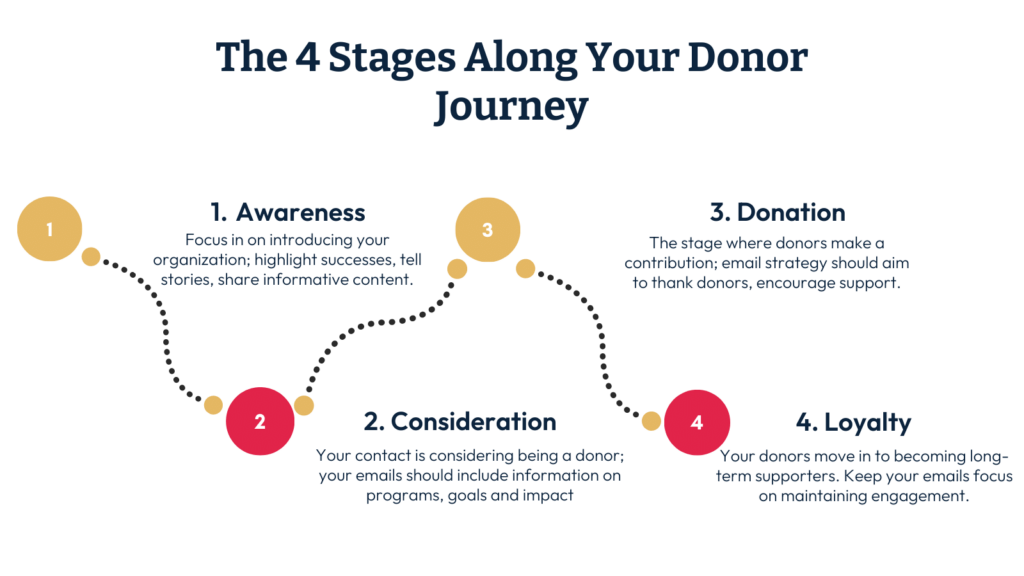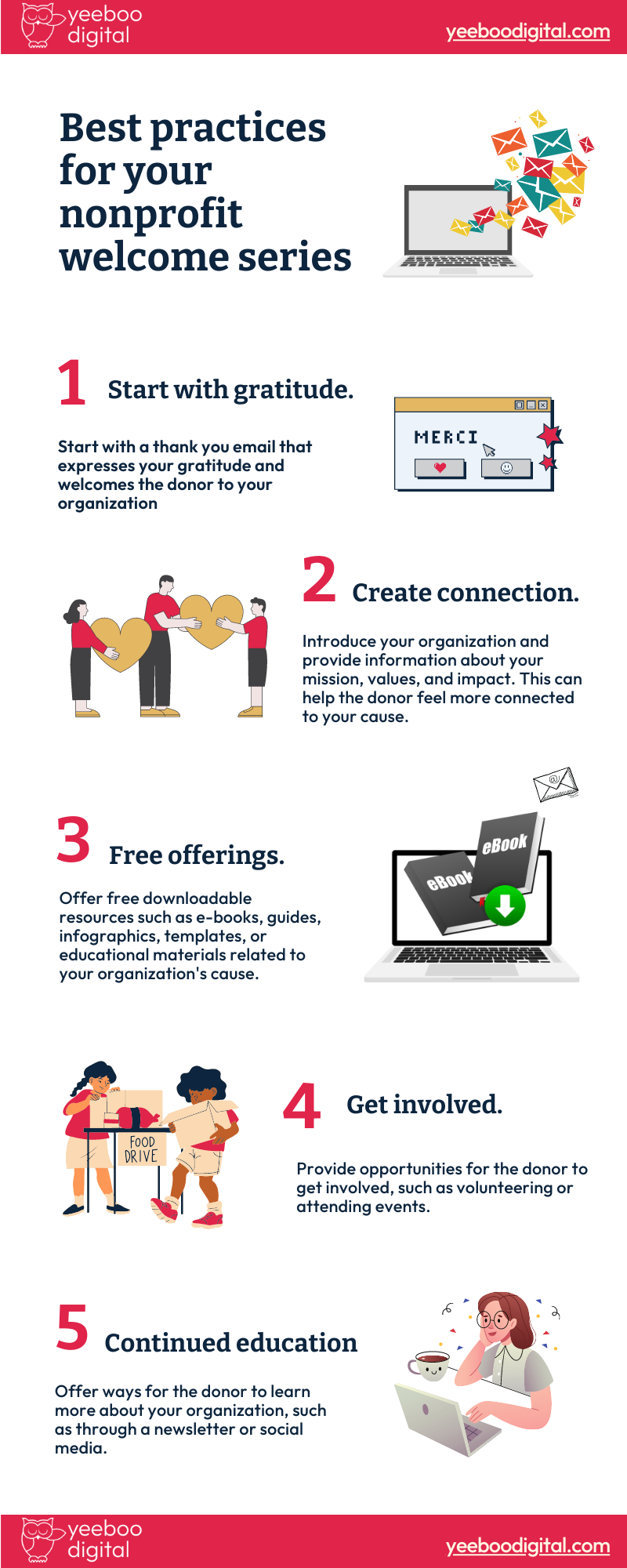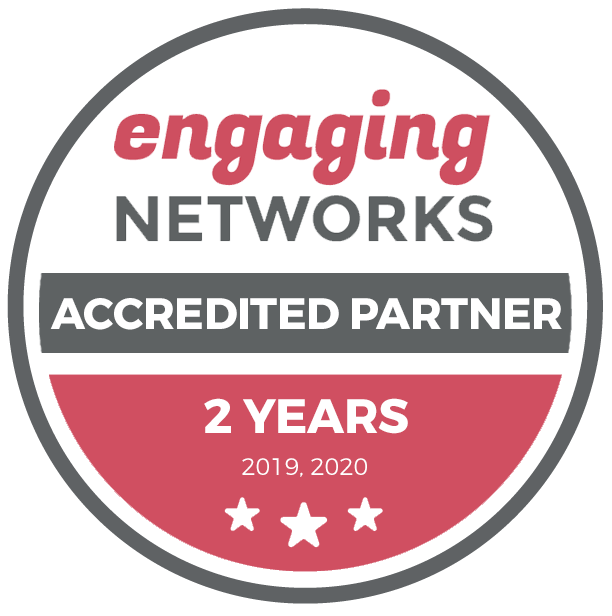Email is an incredibly powerful tool for nonprofits looking to build relationships with their donors. In fact, a recent report from Donor Direct noted that it’s the most effective channel for nonprofits to build awareness, acquire new donors, and generate donations. Pretty impressive, right?
At Yeeboo Digital, we specialize in helping nonprofits create email marketing strategies that engage donors and drive results. Our team of experts is passionate about helping organizations build lasting relationships with their supporters, and we know that email is a key component of that strategy.
In fact our team believes so strongly in email that this month’s article is ALL about email and your donor journey. We’ll dive into the nitty-gritty of how nonprofits can use email to support donors at each stage of the journey, from first-time donors to longtime supporters. We’ll also offer up some pro tips on how to balance automation with personalized communication, so you can create engaging email campaigns that resonate with your audience.
What exactly IS a donor journey?
The donor journey is a critical component of any successful fundraising strategy. Understanding each stage of the journey is essential for effectively communicating with donors and building long-lasting relationships. Let’s explore each stage of the donor journey in-depth and examine the role that email marketing plays at each step.
- Awareness: At this stage, potential donors become aware of your organization’s mission, values, and impact. Your email strategy should focus on introducing your organization to potential donors and building awareness of your cause. This can be achieved through sharing informative content, highlighting your organization’s successes, and telling stories about the impact your work has had on your community.
- Consideration: In this stage, donors are considering making a donation and are looking for more information about your organization. Your email strategy should provide prospective donors with detailed information about your programs, goals, and impact. Consider including testimonials from other donors, showcasing how their contributions have made a difference.
- Donation: This is the stage where donors actually make their first contribution to your organization. Your email strategy should aim to thank donors for their contributions, encourage them to continue supporting your organization, and let them know how their contributions are being used.
- Loyalty: In this stage, donors become long-term supporters of your organization. Your email strategy should focus on maintaining engagement with your donors, providing them with regular updates on your organization’s work, and showing appreciation for their continued support. Consider sharing stories about the impact your donors have had on your community and highlighting how their contributions have made a difference.
It’s important to note that the donor journey may not follow a linear path, and donors may enter or exit at any stage. Your email strategy should be designed to support donors at every stage of their journey, whether they are just learning about your organization or have been loyal supporters for years.

Your nonprofit Welcome Series
When a new donor makes their first contribution to your organization, they have taken a significant step in supporting your cause. This is the perfect opportunity to show your appreciation and establish a meaningful connection. A welcome series is a great way to do this.
A welcome series is a sequence of automated emails that are sent to new donors over a period of time. These emails are designed to thank the donor for their support and introduce them to your organization. They typically include information about your mission, values, and impact. The purpose of a welcome series is to engage the donor and build a relationship with them.
Why is a welcome series important? First, it helps to establish trust and credibility with your new donor. By thanking them and providing them with valuable information about your organization, you are showing that you appreciate their support and are committed to making a difference. This can go a long way in building a lasting relationship.
Second, a welcome series can significantly improve the retention of new donors. According to research by Bloomerang, donors who receive a welcome series are 50% more likely to make a second donation. This is because the welcome series keeps the donor engaged and informed about your organization, which increases their likelihood of making another contribution.
What kind of content works in a welcome series
The content of your email messages is critical to building and maintaining relationships with your donors. Your messaging should aim to engage donors, build trust, and inspire action.
Different types of content are appropriate for different stages of the donor journey. For instance, in the consideration stage, you might share social proof of your organization’s impact through testimonials or case studies. In the loyalty stage, personalized messages acknowledging a donor’s history of support can be effective.
At all stages of the donor journey, the content should be informative and valuable to the recipient. Avoid lengthy emails with too much information or complex jargon. Keep your messaging concise and straightforward, and use a friendly and conversational tone. Consider including images or videos in your emails to make them more visually appealing and engaging.
One important thing to keep in mind when creating content is to make it donor-centric. Focus on the donor and their interests rather than solely promoting your organization. Use language that speaks directly to the donor, and show them how their support makes a difference.
Finally, make sure your email messages are consistent with your organization’s brand and values. Ensure that your messaging is authentic and aligns with your organization’s mission and goals. By doing so, you’ll strengthen your organization’s relationship with your donors and foster a sense of trust and loyalty.

Best Practices for a Welcome Series or New Donor Series
To make the most of your welcome series, it’s important to plan it carefully. Consider the timing and frequency of the emails, as well as the content. You want to strike a balance between providing valuable information and overwhelming the donor with too much information.
Some best practices for a welcome series include:
- Start with a thank you email that expresses your gratitude and welcomes the donor to your organization.
- Introduce your organization and provide information about your mission, values, and impact. This can help the donor feel more connected to your cause.
- Offer free downloadable resources such as e-books, guides, infographics, templates, or educational materials related to your organization’s cause.
- Provide opportunities for the donor to get involved, such as volunteering or attending events.
- Offer ways for the donor to learn more about your organization, such as through a newsletter or social media.
By following these best practices, you can create a welcome series that engages and retains new donors. At Yeeboo Digital, we understand the importance of a well-designed welcome series, and we can help you create one that is tailored to your organization’s unique needs.
Balancing Automation with Personalized Communication
In today’s fast-paced digital world, email automation has become an essential tool for managing email communication at scale. However, it’s important to keep in mind that donors want to feel like they are being spoken to as individuals, not just part of a mass email campaign.
This is where personalized communication comes in. Personalized messages, tailored to the donor’s interests, can help to build a stronger relationship with them. It’s important to remember that donors are human beings with unique preferences, and sending them generic messages will not only result in lower engagement rates but could also lead to them feeling undervalued.
One way to balance automation with personalized communication is to segment your email list. By segmenting your list into smaller, more targeted groups based on shared characteristics, you can tailor your messages to each group’s specific interests and needs. This not only increases the relevance of your messages but also makes your donors feel like they are receiving personalized attention.
Another way to personalize your messages is to use dynamic or conditional content. This is where different content is displayed depending on the recipient’s demographics, behavior, or preferences. For example, you could use dynamic content to show different images or messages to donors based on their location or past donation history.
When using automation, it’s important to ensure that your messages don’t sound robotic or impersonal. One way to do this is by using a conversational tone and including personalization tags, such as the recipient’s name. You can also include a personal message from a real person within your organization, like the founder or CEO.
Conclusion
The power of email lies in its ability to connect with donors on a personal level, and build long-lasting relationships with them. As we discussed throughout this article, the donor journey is a critical component of successful fundraising, and email plays a significant role in that journey.
To recap, we defined the donor journey and discussed the importance of email at each stage. We also covered measuring the effectiveness of your communications and the different types of messaging content that should be included in your emails. We explored the resources required to set up effective email series and provided tips on how to balance automation with personalized communication. Furthermore, we offered best practices for creating a successful welcome series or new donor series.
At Yeeboo Digital, we understand the importance of email marketing and the role it plays in the donor journey. We specialize in helping organizations develop effective email marketing strategies that support their donor journey. Our team of experts is equipped with the necessary skills and knowledge to help you create a successful email campaign that engages your donors and generates revenue.
If you’re interested in learning more about how Yeeboo Digital can help you improve your email communications and grow your donor base, please don’t hesitate to contact us. We’re here to help you succeed and achieve your fundraising goals.
Tasha Van Vlack (article author) is a nonprofit connector, marketer and advocate. She works closely with the Yeeboo Digital team to curate excellent resources that will support nonprofit professionals in advancing their missions.



